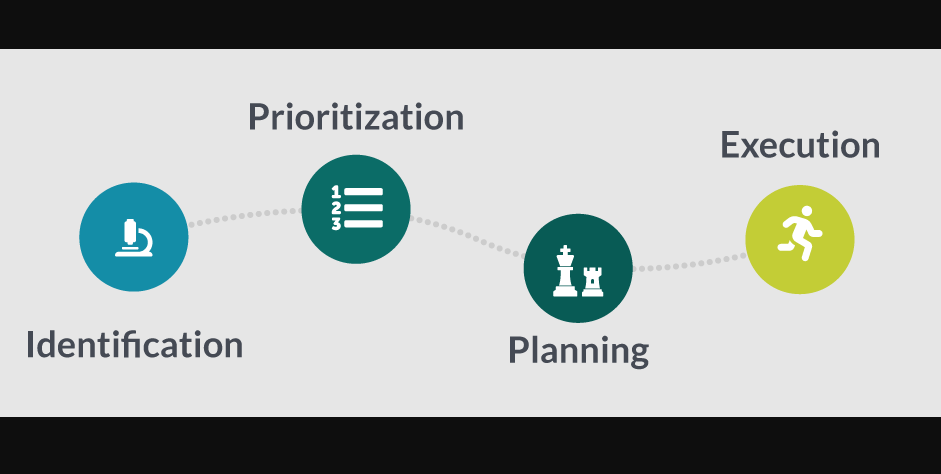Test scenarios are a key function to ensure the swift working of an application during the testing phase. In test case management, one effective strategy is risk-based test case prioritization.
Risk-based test case prioritization focuses on the identification of test scenarios and test cases based on the related potential risks and impacts. With risk priority, organizations can optimize their efforts in high-risk areas and ensure that critical functionalities are tested.
The article discusses the basis of risk-based test case prioritization, its techniques, implementation strategies, challenges, best practices, and how it can be efficiently incorporated into cloud testing environments.
Understanding Risk-Based Test Case Prioritization
A systematic approach to organizing the test cases based on the risks of the software that is going to be tested is known as risk-based test case prioritization. It identifies which feature or component is most probable to fail and would have some consequences. In this way, problems are raised very early in the development cycle.
Why Prioritize Test Cases?
There are numerous reasons for test cases to be prioritized; here are the following reasons,
- Resource Optimization
Organizations suffer from time and resource constraints. Focus on high-risk areas might help testers utilize resources more effectively.
- Early Detection of Defects
Testing high-risk features first can increase the chances of detecting defects early, and it may cut the costs associated with remediation at a later stage of the development process.
- Improved Software Quality
Improved software quality can be attained by full testing of such critical features.
- Trust of Stakeholders
Risk-based tests focus on the severity of quality and reliability that is delivered to the stakeholders.
- Rapider Time-to-Market
Relieving risky areas first can help accelerate product delivery cycles, thus launching the application much sooner than the market competitors.
Techniques for Risk-Based Test Case Prioritization
Some methods of prioritizing test cases based on risk are as follows:
- Risk Assessment
Determine possible risks associated with different features or components of the software under test. Testers assign a risk with a likelihood and impact rating. This then gets plotted in what is called a risk matrix, which explains the priorities.
- Analysis of Past Defect Data
A method of determining what’s likely to fail is through analyzing the data about past defects. Features that have previously shown defects should be given priority in the testing phase.
- Requirement Prioritization
Those test cases corresponding to high-priority organizational requirements are scheduled first. Thus, the most important functionalities are checked first.
- Version-Specific Prioritization
In the case of software updates, test cases that have to do with functions or dependencies are scheduled as a priority to ensure that the newest version introduced does not have any new defects.
- Stakeholder Input
One can ensure that the requirements addressed in the priorities align with and fulfill organizational goals and user expectations when stakeholders are involved in prioritization.
- Exploratory Testing
It will help users uncover some risk factors of an unexpected nature and, therefore, assist them in making decisions about priorities involving real-time observations.
- Risk-Weighted Scoring
There are times when weighing up the scores for each risk involved may become necessary based on how probable and impactful the risk is. Team members can be assigned scores to their features or components to calculate their risk score so that testing can be done systematically with priorities being sorted.
- Impact Analysis
Identifying how one particular part of the application impacts another component is an important part of what should be given priority during tests.
Implementing Risk-Based Test Case Prioritization
To implement risk-based test case prioritization, the below steps should be followed:
Risk Criteria Definition
Criteria to be settled by an organization in terms of determining how much risk is involved for different features. For example,
- Organizational Impact
Risk is assumed to be high if a feature has critical importance in organizational operations.
- Complexity
High risk is tagged if it has been decided that the feature is highly complex in implementation and/or testing.
- User Impact
If there is a probable impact on users due to the failure of the feature, then it is a high-priority feature that needs immediate attention.
- Regulatory Compliance
The more frequently the feature is used, the more thorough testing is required.
Risk Assessment
Evaluate the risks that you have chosen to include using a risk matrix or scoring system. This enables you to give a score to the likelihood and impact of each risk.
Selection of Test Cases and Prioritization
Based on the identified risks, choose the test cases with priority. Prioritize the ones related to high-risk areas over them.
Periodic Review and Update
Risks and requirements change over time. The prioritization strategy should be reviewed and updated according to new information that may come along, like changes in requirements or changes in feedback by testing.
Communicate Priorities
Ensure that all the members of your team are aware of the prioritization process and its needs. Good communication promotes teamwork and ownership by all the members.
Record Testing Outcome
You should record the outcome of your testing so that you can determine the extent to which your prioritization was effective. Use this outcome as a basis to enhance your future assessment.
The Role of Cloud Testing in Risk-Based Prioritization
Cloud testing has transformed how organizations approach their quality assurance by making scalable resources and environments available for testing across a diversity of devices and browsers. One such cloud-based platform is LambdaTest.
It is an AI-powered test execution platform that allows you to run manual and automated tests at scale across various 3000+ browsers and OS combinations.
With this platform you can execute a risk-based test case prioritization strategy much more effectively than any other method and platform in the market. This is further enriched by AI testing tools that can streamline the application, with high-risk areas being identified so that testers know what matters most.
The addition of AI testing tools in the operations leads to streamlined and faster processes that not only enhance the accuracy of testing processes but ensure all critical functionalities get thoroughly vetted before deployment.
Benefits of Cloud Testing for Risk-Based Test Case Prioritization
Cloud testing brings about benefits such as scalability, mainly in the effectiveness of risk-based test case prioritization. Especially with LambdaTest:
Within a cloud platform, thousands of browser and device combinations can be accessed by testers. They can run tests in parallel across different environments by scaling up.
- Faster Feedback Cycles
These platforms offer fast turnaround times, allowing developers to address issues promptly when they become out of control, ensuring that serious functionalities are enhanced early in the development process, and preventing potential issues.
- Cost-Effectiveness
Organizations can save money as they no longer have to maintain significant infrastructure that needs to be located locally.
The allocated resources can therefore be used to make much more intensive tests of high-risk areas without having to worry about overheads associated with physical hardware.
- Accessibility
Remote teams can work on test environments from remote locations, thus working remotely as well as collaborating using cloud-based testing.
This would be a key requirement specifically for teams spread across multiple locations to ensure all the team members are accessible and contributing toward risk assessment and testing in a smooth, uninterrupted manner.
- Integration Capabilities
Many of the cloud platforms natively complement continuous integration and continuous deployment (CI/CD) pipelines, thereby permitting auto-testing in conjunction with integration processes.
Cloud testing platforms ensure that risk-based case prioritization of test cases should be incorporated within the workflow for development and constantly updated according to such assessments.
- Test Execution
Through cloud testing, organizations can execute automated tests across multiple environments swiftly. Through the above platform, teams can focus directly on high-risk areas with no delays, thus giving a very important momentum advantage in agile development cycles.
- Improved Test Reliability
Cloud platforms, in general, offer features like auto-healing capabilities that help overcome flaky tests by automatically recovering from some failures without any human interaction involved.
- Wide Access Environment
Cloud testing gives access to thousands of desktop and mobile environments on demand. Teams through LambdaTest’s exhaustive pool of over 3000 real devices and browsers can ensure complete coverage of cross-browser compatibility testing. That too, with much less chance of unforeseen bugs cropping up when it goes into production.
- Compliance Security
Many cloud platforms ensure protection in testing while meeting industry standards. LambdaTest offers security and ensures compliance with regulations, including SOC2 Type 2 and GDPR; this helps organizations keep stakeholders’ trust intact alongside effective risk management.
- Real-Time Collaboration
Cloud platforms usually offer collaborative functions for the testing team, even during the testing phase. These platforms can solve problems faster and can also impart teamwork, which is essential while addressing high-risk areas identified in prioritization.
With the benefits of cloud testing via a LambdaTest, an organization can indeed ensure efficient risk-based test case prioritization and thereby achieve better efficiency with quality along with the software.
Challenges in Risk-Based Test Case Prioritization
Although risk-based test case prioritization has many advantages, some challenges are also associated with it:
- Accurate Risk Identification
The precise risks can hardly be measured without critical expertise in technical and organizational needs.
- Dynamic Requirements
Most of the projects experience changing requirements that leave their requirements in questionable scenarios to be evaluated time and again for risks.
- Team Alignment
Team members need to align themselves with the priorities, which is again painful but inevitable for successful execution.
- Balancing Coverage and Focus
High-priority areas have to be covered, but not at the expense of completely ignoring the areas with lower priorities, as these, too, can be extremely challenging if left untested.
- Documentation Overhead
Detailed records of risks and priorities require a fair amount of effort to maintain, but they are needed for visibility and accountability.
- Resistance to Change
Teams that have traditionally applied testing may resist the risk-based approach because they do not know how to perform it or perceive it as too complicated.
- Overreliance on Tools
Automated tools can streamline the process but create loopholes in risk assessment if human oversight is not involved.
Best Practices for Effective Risk-Based Test Case Prioritization
The following best practices can be used to ensure maximum effectiveness in risk-based test case prioritization:
- Engage Cross-Functional Teams
Draw members from development, quality assurance (QA), product management, and other departments participating in risk assessment to bring diverse perspectives.
- Automation Must Not Be Misused
Utilize automation tools in a manner that helps to run tests across multiple environments with efficiency and directs the human effort to high-risk areas where it is required.
- Train Teams Regularly
Organize various sessions on risk assessment techniques so that training is done repeatedly for all the team members.
- Continuous Learning
You must have a culture of learning in your organizations wherein the teams share insights from previous projects to help improve assessments for future ones.
- Scheduled Review of Risk Assessments
Make scheduled reviews for your risk assessments. Changes in project scope or technology landscape are incorporated into your risk assessment.
- Leverage Metrics for Decision-Making
Metrics from previous projects (e.g., defect density or severity) can be used as benchmarks when trying to assess risks on a new project.
- Keep Documentation Clear
Ensure clear documentation about all assessments before making the decisions so that the decisions made can be considered transparent and justifiable in the best way possible.
- Feedback Loops Post-Test Execution
After the test cases have been executed based on the prioritized cases, solicit feedback from testers regarding any unexpected outcomes or additional risks discovered in execution should be recorded and worked upon.
Conclusion
To conclude, risk-based test case prioritization is a method that enhances software quality and minimizes resources by focusing on high-risk areas and identifying defects early. This approach is effective due to scalable resources, fast feedback loops, and cloud testing platforms. It simplifies testing efforts and aligns them with organizational goals.
Agile methodologies and rapid development cycles can be used for effective risk management. Using platforms like LambdaTest and tools like Selenium and Cypress can enhance processes, provide critical features with attention, and lead to more efficient workflows in a competitive environment.










